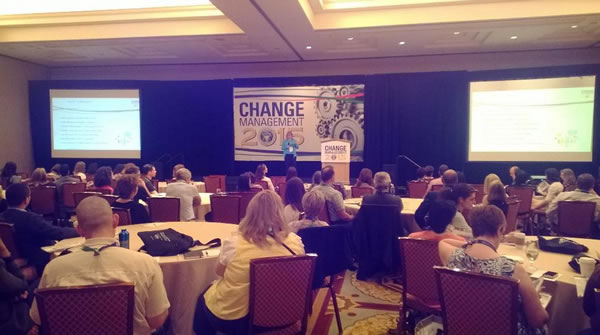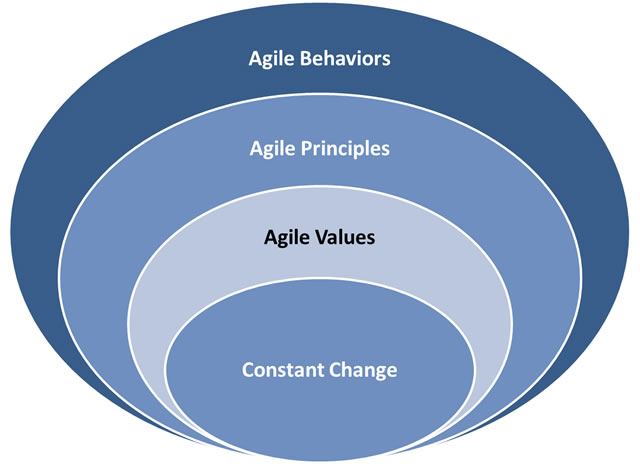
Recently I had the opportunity to attend the Association of Change Management Professionals’ (ACMP®) annual conference in Las Vegas, Nevada, titled appropriately Change Management 2015. The event represented a convening of nearly 1,000 change management professionals from around the globe, including countries as geographically dispersed as Qatar and Australia, but with the bulk of the attendees being from the United States, Canada, and Australia.
Nearly 1,000 attendees is a pretty decent size, much bigger than any innovation event that I’ve ever been to, but this larger number of attendees is quite small when you consider the number of people serving in official or unofficial change management roles around the world (either as employees or consultants), or when compared to the number of project managers (estimated at 16.5 million people around the world) and potentially as many as 1.5 million six sigma black belts and green belts sprinkled around the world.
Meanwhile, a couple of the leading training organizations in the change management space have trained just short of 100,000 people in the principles of change management.
If you agree that proactively managing change in organizations is at least as important as the practice of Six Sigma, and potentially as important as project management, that means that as the pace and importance of change continues to gather steam, there could be the need to train between 1.4 million and 16.4 million change management professionals in the next few years.
Professionalizing the Change Management Profession
One of the things that occured at the conference was the highlighting of the ACMP Standard for Change Management™ and the new ACMP Qualified Education Provider™ (QEP™) program. Both of these are steps along the way to building momentum for a change management certification that the ACMP® hopes will become the gold standard for people worldwide to highlight that they have the skills knoweldge, and experience to be recognized as a Certified Change Management Professional™ (CCMP™).
Kicking it off with Dan Pink
The opening keynote at the event was delivered by Dan Pink, author of ‘Drive’ and several other books. Much of his speech was about the societal impacts of the greater availability of information that we enjoy today, and how that will also affect our ability to sell, to influence, and to affect change. In sales, it used to be that the seller nearly always had more information than the buyer, that is rarely the case any more. Because of this shift in information availability, experts are being called on more to be a curator of information than as a way to access information. Dan highlighted how nearly everything that we do in business involves sales and change, yet business schools and MBA programs teach neither sales nor change (they might teach a course on leadership if you’re lucky). And if the ABC’s of sales used to be “Always Be Closing” then the new ABC’s of sales are Attunement, Buoyancy and Clarity.
One interesting personal productivity insight that Dan shared was the idea that asking yourself questions before doing something is a better preparation method than positive self talk. Another was how by reducing your feelings of personal power before going into a conversation can actually increase your effectiveness at getting people to do something. And finally, consider these points related to change:
- Context is more important than the individual
- When engaging people for change, it’s very important to use the audience’s language not yours
- Instead of focusing on changing people’s minds, focus on making it easy for people to do something
- When information goes down easier it is more likely to stick (rhyming, distillation, etc.)
The IBM Research Perspective
There was a great quote from Hilary Bland of IBM at the conference that illustrates the necessary future direction and importance of change management:
“The ability to anticipate, manage and capitalize on pervasive change is often the difference between market leadership and extinction.”
Between IBM’s research study in 2008 and their followup study in 2014, they’ve seen a shift from organizations managing change on projects to organizations increasingly focusing on enterprise transformation. While the 2008 study examined how organizations manage change and gained practical knowledge, the 2014 study gained insights into the new environment of continuous transformation & the attributes of organizations that are highly successful in managing change.
One of the findings from IBM’s 2014 study was that 74% of respondents are concerned employees are not fully prepared to adapt to an increasingly digital work environment. This sentiment also manifests in the finding that only 20% of organizations successfully deliver on more than 75% of their projects.
And while the digital revolution provides new opportunities to lead change – bottom-up, top-down, sideways – the fact is that 87% of the IBM study respondents stated that not enough focus is currently placed on change management in critical projects and that only 44% of high performance change organizations understand change benefits – Scary!
On final interesting tidbit from the 2014 IBM Research findings – In 2008 only 20% of surveyed companies were using internal resources to manage change projects, but this number is 84% now – highlighting a perceived need for companies to build their own internal change management capability instead of relying on consultants.
Here is a link to the latest IBM study ‘Making Change Work 2014’ – https://ibm.biz/BdRV9y
Gearing Up for Change – A Case Study
Columbia Sportswear shared several learnings from the change management components of their SAP upgrade, including:
- Success comes not from just saying things multiple times but doing things multiple times
- We had to stress that company success is determined by the quality of and access to data
- Initially we were given a tiny training budget, so we went out and got data to build support for an increase
- We used learnings from a previous failure to build support for our new approach
- Our first steps were to capture tribal knowledge, map processes, and write standard operating procedures (SOP’s)
- We then trained execs in our change methodology and did monthly change surveys to
- We won support from senior management to bring in long term temporary employees to free up our super users to participate in the project. This was a priority!
- Focus was key! The company had to say “We’re going to do this upgrade, make/sell products, and nothing else!” – and then of course remind people…
- We had to get creative in our communications, both in terms of building new communication channels and creative messaging, but also we had to work really hard not to talk about the system being changed, but instead focus on how this was a company evolution.

The Culture Question
There were several good culture questions and comments that came up from various sessions, including:
- When it comes to culture change, you have to define which parts of the culture you’re going to retain too.
- Findings from IBM’s study on making change work… 1. Lead at all levels 2. Make change matter 3. Build the muscle
- People at IBM got social really fast around the topic of change because managers were looking at profiles and who was contributing
- Engagement = Communication + Co-creation
- Successful change efforts blend effective approaches to the task side and the people side
- Pace of change is both a driver for change management and a resistor
- Accountability key to embedding your change into normal operations
- People hate being off plan. They will want to tell people about the green behind the red. Consider only allowing people time with the boss to discuss yellow/red projects and how the boss can help, instead of making people feel like they have to be green.
- When change saturation exists, consider having cross-functional resource conversations to look for solutions.
- “Change has to start by doing less” -Lisa Bodell
- “Change Leaders should keep these three things in mind – Ask killer questions, Reverse assumptions, and Kill a stupid rule” – Lisa Bodell
Learning as it Relates to Change
There was a great session at the Conference with Christine Cox, PhD. looking at breakthroughs in organizational learning. Some of the key takeaways included:
- People who multitask (or who sit next to multitaskers during lectures) exhibit lower comprehension
- Memory can be improved by relating learning to yourself
- To harness emotion for better learning you want to tap into people’s emotions without overactivating them
- People strongly remember moments where they made connections and generated those connections or insight
- Learning is also increased when the right social elements are added
- Give people opportunity to share what they’ve learned and reflect on its self-relevance
- Spacing is also important for learning. No cramming!
- 12 hour learning spacing that includes a night’s sleep helps comprehension more than 12 hours of spacing during waking hours
- Instructional design should perhaps shift from content delivery to creating the space for insight
- Incorporating some forms of generation into the learning situation – like polls, guided reflection, writing answers, explaining to another, hearing from another – can increase retention
All Trains Change for Change
Carmen Bianco, the President of the Manhattan Transit Authority (MTA) discussed how our world is changing and how the MTA has to focus on technology, strategy and culture. One of the big questions the MTA is grapplin with is:
How can we get more technology underground so that we can get more train cars per hour moving through the system?
The MTA is ordering 1,000 new train cars and growth is causing them to explore how they can change their culture to be more customer-focused and how they can move more train cars per hour and how they can get more people into each train car. Carmen’s initial focus on culture change has been on top executives so that the middle of the organization knows they’re serious. For change to filter all of the way down, the alignment and commitment has to work its way down. Carmen feels that if he can get everyone on his team to be that good boss, that’s a home run because it effects countless numbers of people. Carmen has also instituted no meeting days at MTA where he requires managers to get out with their employees and then do a debrief with him at the end of the day.
Carmen spoke about the challenge they face with 44% of executives and 41% of operating supervisors becoming pension eligible soon. The potential retirement of 44% of managers next year is both a risk and an opportunity to culture change progress. He spoke about how just when it seemed like he wasn’t changing the culture, the super storm came and provided a galvanizing opportunity. He marveled as he watched the MTA perform with the customer in mind (even sacrificing sleep). He feels blessed to have a phenomenal group of employees who have come up with ideas like FastTrack, where we had 900 employees working in the same area. At first citizens and the media ridiculed the idea, but now people are asking ‘When are you bringing this to my neighborhood?’ The creation of FastTrack reminded me of that scene in the Apollo 13 movie. It’s a good idea to keep that Apollo 13 scene ‘What do you have?’ in mind for constraint-focused brainstorming.
A Whirlwind Tour of Change
The Nike and Peoplefirm session highlighted the importance of communication strategies and creativity in change. PG&E and BeingFirst highlighted how building a change capability within an organization takes time (within PG&E it has taken 2 1/2 years just to START). Year 1 at PG&E may have focused on a lot of change leadership training, but year 2 has to be more about demonstrating results. An internal change group can act as middleware translator between consultants and the organization on a range of projects. Change saturation was discussed many times at the conference, and PG&E talked about how they monitor it at a workgroup level, monitoring what initiatives are effecting different workgroups. In the Marriott session it was highlighted that the most used change tools at Marriott include change overview, stakeholder analysis and communication plan. Chris Churchill and Paul O’Keeffe of Accenture spoke about Agile Change Management and the importance of integrating your change process into your Aigle process, including your task wall or kanban wall process.
Finally, closing keynote speaker Lisa Bodell offered these Eight Statements for Change that she advises organizations work to answer in the affirmative:
- People in our organization actively think about pushing boundaries and use trends
- Our employees are comfortable asking provocative questions
- People think on their feet
- People see it through
- We are Looking forward 5-10 years
- We constantly push for continual improvement
- We purposefully hire diverse teams
- We look at adjacencies and distant companies and apply best practices
The conference definitely was a whirlwind, and I’d like to thank the Change Management 2015 conference organizers for inviting me to cover the event for the Innovation Excellence audience. Hopefully they’ll have me back as a speaker next year at Change Management 2016 in Grapevine, Texas.
In 2016 my new change management content site will be in full swing and my second book for Palgrave Macmillan (@PalgraveBiz) comes out in January 2016 to highlight the best practices and next practices of organizational change and introduces the new collaborative, visual change planning toolkit. I’ve got some great guest experts lined up as contributors and am finalizing the final few sponsors and contributors in the next couple of months (along with the manuscript), so stay tuned!

 Sign up here to get Human-Centered Change & Innovation Weekly delivered to your inbox every week.
Sign up here to get Human-Centered Change & Innovation Weekly delivered to your inbox every week.
 by Braden Kelley
by Braden Kelley![]() Sign up here to get Human-Centered Change & Innovation Weekly delivered to your inbox every week.
Sign up here to get Human-Centered Change & Innovation Weekly delivered to your inbox every week.




